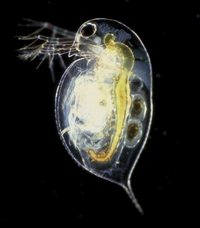
Photo from wikipedia
Although systematics of the cladoceran genus Daphnia (Cladocera: Daphniidae) has been intensively investigated for decades using both morphological and genetic approaches, new lineages are being discovered on all continents, including… Click to show full abstract
Although systematics of the cladoceran genus Daphnia (Cladocera: Daphniidae) has been intensively investigated for decades using both morphological and genetic approaches, new lineages are being discovered on all continents, including in well-studied regions. Among Holarctic daphnids, Daphnia curvirostris Eylmann, 1887 held an interesting position, sharing some morphological characters of both the D. pulex and D. longispina groups. Recently, additional species of the D. curvirostris complex have been discovered in the Eastern Palaearctic. Here, we describe a new species in this complex from Central Europe, D. hrbaceki sp. nov. It was discovered in small, newly created fishless pools in the Czech Republic, and an additional sample of apparently the same taxon was collected in 1951 in Slovakia. D. hrbaceki is the closest yet known relative of D. curvirostris, but remains genetically divergent from all members of the complex (based on the sequences of three mitochondrial genes: 12S, COI, and ND2). In general, adult females of this species are morphologically very similar to D. curvirostris. Unlike the latter species, D. hrbaceki may develop a specific hump-shaped dorsal outline of the carapace, presumably an inducible defence against invertebrate predators. Juveniles of the new species occasionally form neckteeth, which may also be retained in adult individuals. The species also shows substantial variation in the size of spines in the middle pecten of the postabdominal claw, similarly as in the Japanese member of the species complex, D. tanakai Ishida, Kotov & Taylor, 2006. This variable character of spine size in the postabdominal middle pecten (a transition from the pulex to the longispina group character), as well as a bent and heavily setulated terminal seta on the male 2nd endopodite (considered as the pulex group character), are typical for the new species. D. hrbaceki also differs from D. curvirostris as well as other members of the complex in the ephippial surface ultrastructure. Our study demonstrates the utility of such ultrastructural characters in Daphnia taxonomical studies.
Journal Title: Zootaxa
Year Published: 2019
Link to full text (if available)
Share on Social Media: Sign Up to like & get
recommendations!